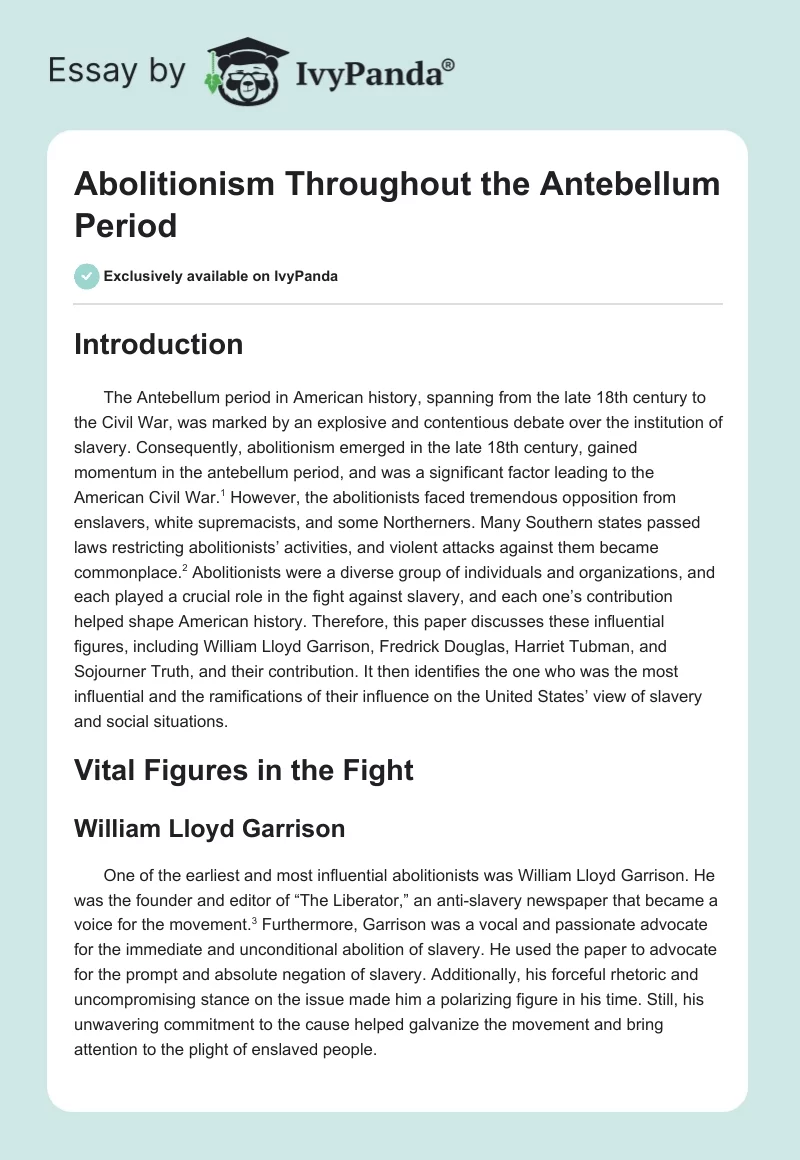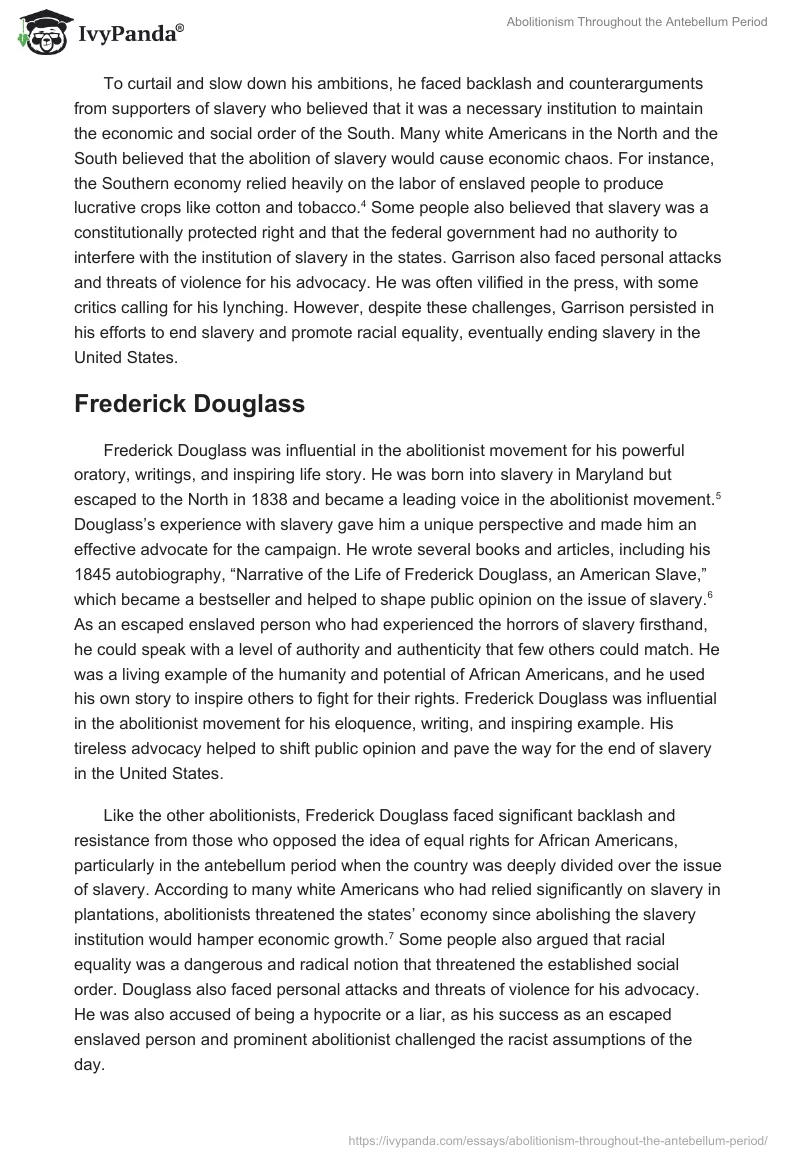Introduction
The Antebellum period in American history, spanning from the late 18th century to the Civil War, was marked by an explosive and contentious debate over the institution of slavery. Consequently, abolitionism emerged in the late 18th century, gained momentum in the antebellum period, and was a significant factor leading to the American Civil War. However, the abolitionists faced tremendous opposition from enslavers, white supremacists, and some Northerners. Many Southern states passed laws restricting abolitionists’ activities, and violent attacks against them became commonplace. Abolitionists were a diverse group of individuals and organizations, and each played a crucial role in the fight against slavery, and each one’s contribution helped shape American history. Therefore, this paper discusses these influential figures, including William Lloyd Garrison, Fredrick Douglas, Harriet Tubman, and Sojourner Truth, and their contribution. It then identifies the one who was the most influential and the ramifications of their influence on the United States’ view of slavery and social situations.
Vital Figures in the Fight
William Lloyd Garrison
One of the earliest and most influential abolitionists was William Lloyd Garrison. He was the founder and editor of “The Liberator,” an anti-slavery newspaper that became a voice for the movement. Furthermore, Garrison was a vocal and passionate advocate for the immediate and unconditional abolition of slavery. He used the paper to advocate for the prompt and absolute negation of slavery. Additionally, his forceful rhetoric and uncompromising stance on the issue made him a polarizing figure in his time. Still, his unwavering commitment to the cause helped galvanize the movement and bring attention to the plight of enslaved people.
To curtail and slow down his ambitions, he faced backlash and counterarguments from supporters of slavery who believed that it was a necessary institution to maintain the economic and social order of the South. Many white Americans in the North and the South believed that the abolition of slavery would cause economic chaos. For instance, the Southern economy relied heavily on the labor of enslaved people to produce lucrative crops like cotton and tobacco. Some people also believed that slavery was a constitutionally protected right and that the federal government had no authority to interfere with the institution of slavery in the states. Garrison also faced personal attacks and threats of violence for his advocacy. He was often vilified in the press, with some critics calling for his lynching. However, despite these challenges, Garrison persisted in his efforts to end slavery and promote racial equality, eventually ending slavery in the United States.
Frederick Douglass
Frederick Douglass was influential in the abolitionist movement for his powerful oratory, writings, and inspiring life story. He was born into slavery in Maryland but escaped to the North in 1838 and became a leading voice in the abolitionist movement. Douglass’s experience with slavery gave him a unique perspective and made him an effective advocate for the campaign. He wrote several books and articles, including his 1845 autobiography, “Narrative of the Life of Frederick Douglass, an American Slave,” which became a bestseller and helped to shape public opinion on the issue of slavery. As an escaped enslaved person who had experienced the horrors of slavery firsthand, he could speak with a level of authority and authenticity that few others could match. He was a living example of the humanity and potential of African Americans, and he used his own story to inspire others to fight for their rights. Frederick Douglass was influential in the abolitionist movement for his eloquence, writing, and inspiring example. His tireless advocacy helped to shift public opinion and pave the way for the end of slavery in the United States.
Like the other abolitionists, Frederick Douglass faced significant backlash and resistance from those who opposed the idea of equal rights for African Americans, particularly in the antebellum period when the country was deeply divided over the issue of slavery. According to many white Americans who had relied significantly on slavery in plantations, abolitionists threatened the states’ economy since abolishing the slavery institution would hamper economic growth. Some people also argued that racial equality was a dangerous and radical notion that threatened the established social order. Douglass also faced personal attacks and threats of violence for his advocacy. He was also accused of being a hypocrite or a liar, as his success as an escaped enslaved person and prominent abolitionist challenged the racist assumptions of the day.
Harriet Tubman
Harriet Tubman was another key figure in the abolitionist movement. She was a formerly enslaved person who escaped to freedom and became a “conductor” on the Underground Railroad, a network of secret routes and safe houses used by enslaved people to escape to freedom. Tubman was responsible for leading dozens of enslaved people to liberation and was known for her bravery and resourcefulness. She also worked as a spy for the Union Army during the Civil War, helping to secure crucial military intelligence and aiding in the effort to end slavery.
Tubman faced considerable backlash from those who supported slavery and those who opposed the idea of women taking on such a public and influential societal role. Foremost, when she escaped slavery and became a conductor on the Underground Railroad, she was constantly at risk of being caught and returned to slavery. Moreover, Tubman had to navigate unfamiliar terrain and dangerous conditions to lead other enslaved people to freedom. She also had to rely on the support and cooperation of other abolitionists, who faced threats and persecution from pro-slavery forces. As an abolitionist and activist for women’s suffrage, Tubman faced opposition and resistance from those who opposed equal rights for African Americans and women. She was often marginalized and dismissed by those in power, and she had to fight to be heard and taken seriously.
Sojourner Truth
Sojourner Truth was a fascinating orator who delivered lectures on her experiences growing up as an enslaved woman and later as an activist for women’s rights. Her contributions helped bring attention to the horrors of slavery and the critical need for civil rights legislation. However, she was met with significant opposition and retaliation, notably from those against women’s suffrage and equal rights for African Americans.
One of the main counterarguments to Truth’s advocacy was that her views were too radical and extreme. Many people believed that Truth’s calls for immediate and unconditional emancipation and universal suffrage were unrealistic and dangerous. They argued that incremental and gradual change was necessary to avoid social and economic disruption. In addition, Truth faced criticism and discrimination based on her race and gender. As an African American woman, she faced a double burden of discrimination and marginalization. She was often dismissed or ignored by those in power, and her activism was met with hostility and ridicule by most Americans. Moreover, some critics also attacked Truth’s character and credibility, accusing her of being illiterate and mentally unstable.
The Most Influential Abolitionist
Of all these figures, William Lloyd Garrison was the most influential figure. He was a forceful and persuasive speaker and writer, and his newspaper “The Liberator” was widely read and helped to establish the abolitionist movement as a powerful and vocal force. This made him stand out from the rest, as his efforts were comprehensive and far-reaching. Furthermore, Garrison’s uncompromising stance against slavery and his call for immediate liberation helped to rally abolitionists and shift public opinion against slavery. He was also a key organizer and leader in the abolitionist movement and helped to found the American Anti-Slavery Society. While it is difficult to definitively say which figure was the most influential in the abolitionist movement, it is clear that William Lloyd Garrison’s contributions were significant and far-reaching.
Ramifications
Indeed, the abolitionist movement and the fight against slavery had long-standing ramifications on how the United States viewed slavery and the social situations of the mid-19th century. Foremost, the campaign played a critical role in shifting public opinion on the issue of slavery and helped to create a national conversation about the morality and legality of the institution. It also helped to develop a sense of urgency around the issue of slavery, which ultimately led to the Civil War. The conflict between the North and the South primarily resulted from deep-seated divisions over the issue of slavery and the ongoing efforts of abolitionists to end the institution. In addition to their efforts to end slavery, many abolitionists also advocated for civil rights and equality for African Americans. The movement also helped lay the groundwork for the Reconstruction Era that followed the Civil War, during which the government implemented many critical civil rights reforms.
Conclusion
Overall, the abolitionist movement played a pivotal role in shaping American history and helped create a more just and equitable society for all Americans. Each abolitionist made an essential and lasting impact on the fight against slavery, and their collective efforts were instrumental in shaping public opinion and ending this inhumane institution. While the fight against slavery was long and arduous, the legacy of the abolitionists continues to inspire and inform social justice movements to this day.
Bibliography
Chism, Jonathan. “‘Go on or Die’?: Historical and Ethical Analysis of Harriet Tubman’s Authoritarian Rule to Shoot Feeble Fugitive Slaves.” Journal of Disability & Religion, (2022): 1–26. Web.
Kelley, Mary. “‘The Difference of Colour’: Reading and Writing Abolitionism.” Social Dynamics 45, no. 1 (2019): 156–173. Web.
Payne, B. Keith, Heidi A. Vuletich, and Jazmin L. Brown-Iannuzzi. “Historical Roots of Implicit Bias in Slavery.” Proceedings of the National Academy of Sciences 116, no. 24 (2019): 11693–11698. Web.
Quanquin, Hélène. “Abolitionism and the Antebellum U.S. Women’s Rights Movement: The (Missed) Connections of the First National Woman’s Rights Convention (1850).” Études anglaises 74, no. 4 (2022): 482–493. Web.
Raynaud, Claudine. “Sojourner Truth : Christian Faith, Abolitionism, Feminism.” Études théologiques et religieuses 94, no. 2 (2019): 231–252. Web.
Torres, Jacquelyn. “The Evolution of Frederick Douglass’ Slavery Debate: An Examination of His Rhetoric.” Thesis, Dominican Scholar, 2022.


